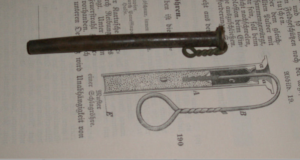In my chronology of initiation systems, a couple of posts down, I omitted the evolution of the “pull primer” as a means of initiating charges, including artillery pieces. I think it’s worth a look at, especially since they were clearly used to initiate the IED used to sink the USS Cairo, below.
- Originally in cannon, bags of gunpowder were stuffed in the muzzle and pushed to the far end of the cannon.
- The bag was then pricked so the priming fire could reach the main charge, by inserting needle like device through the vent hole into the bag charge. The vent is a small hole drilled at the rear of the cannon that led to the inside of the barrel where the bag of gunpowder sat.
- Then loose gunpowder was poured in to the vent. That loose gunpowder was then ignited with a slow burning fuse, red hot iron, or other flame like a portfire to the touch hole, or top of the vent. At one stage a paper tube was inserted that held a preloaded quantity of powder to allow a pre-loaded quantity of powder.
- That method was a little crude, and in 1765 an improvement was developed, which was to insert a tin tube containing blackpowder into the vent. This ensured that the end of the powder train in the tube was in the right physical position to ignite the main charge, increasing reliability.
- Later the tin tube was replaced with a goose quill.
- In the late 1700s a flintlock mechanism began to be used to initiate the vent powder.
- In 1846 a Hanoverarian artillery officer invented the pull primer. This consisted of a tube (usually copper) which contained blackpowder as before, but also a friction sensitive match compound. Inserted into the tube was length of flattened, serrated wire, which when pulled through the match compound created enough heat from friction to cause the match compound and then the powder to ignite. This became a reliable, weatherproof, initiator for artillery pieces, and the post on the sinking of the USS Cairo below demonstrates how such a mechanism can be used for IEDs as a command initiation system from a distance, or as a component of a booby trap pull switch.

In typical pull primers the base of the tube is closed by varnished paper, and the top by shellac putty and varnished paper. A ring is attached to the top of the wire that protrudes through the shellac putty. The operator used his “lanyard” to clip onto the ring and pull from the side – lanyards now are an archaic part of a lot of military uniforms. The match composition was usually a mix of potassium chlorate and another compound.
Friction primers were eventually replaced by percussion primers, which essentially were a percussion cap fitted to the top of the tube, which a mechanism on the gun struck.

Please foot note that this image was taken from my collection web site: https://www.lovettartillery.com/GER_Friction_Primer_9cm_Kanone.htm
Author
Certainly Ralph. Thank you.